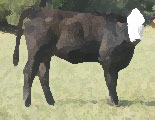We are raising organic beef. Though we are not certified at this time, we are following the rules. One particular aspect of being organic is not using synthetic nitrogen fertilizers. This is a big deal when most livestock producers around you are using synthetic nitrogen. The benefits touted are more grass for hay and forage and the grass responding to the nitrogen will respond better than the weeds. In the words of one rancher on our decision to not use synthetic nitrogen fertilizer- "You won't get nothin' from that land without it".
After some reading its clear that there are a number of ills associated with using synthetic nitrogen, including: reliance on fossil fuels to produce it, changing soil chemistry, investing in methods requiring intervention as opposed to using time & energy in other methods that may be more productive.
A few sites detailing the ills of synthetic nitrogen:
http://hollandimac.chem.rochester.edu/n2cycle.pdf
http://www.nofa.org/tnf/nitrogen.php
http://www.farmandranchguide.com/articles/2006/05/25/bullseye/production_news/prod10.txt
Finally, i mentioned "other methods" above that could be used instead of synthetic nitrogen. This is where I want to begin to focus my attention. Some ideas are:
1) Management intensive grazing. For reading see: http://www.amazon.com/gp/product/0961780738/102-1149708-9712913?v=glance&n=283155
2) Overseeding legumes. Legumes fix nitrogen so used in permanent pastures can have a positive impact. Timing on this is critical.
3) Planting combinations of early & late season grasses to extend the grazing season. (I have some references on this that i'll post when i find them)
4) Fencing off creeks and providing water in the pasture. This helps keep nutrients on the pastures where they belong instead of the creeks where they cause no end of problems. We are pursuing options with WRP and CREP currently to help fence our nearly 2 miles of creek frontage.
More on this topic later!


